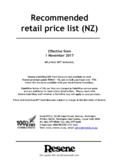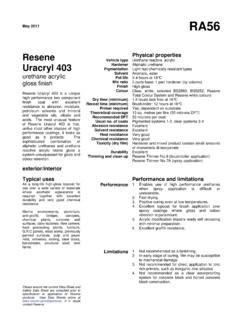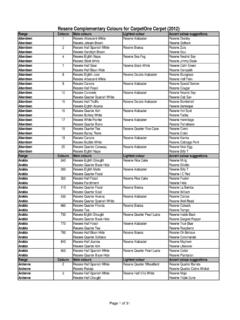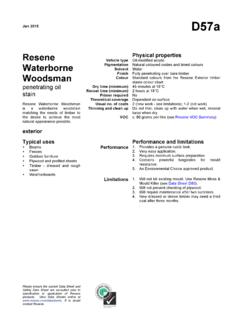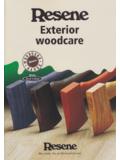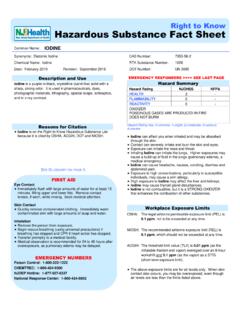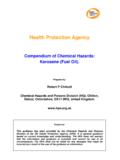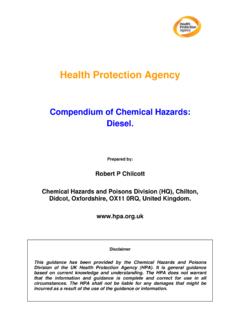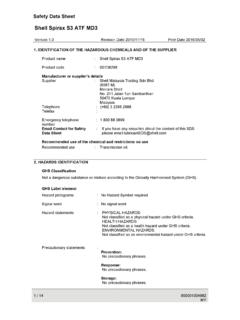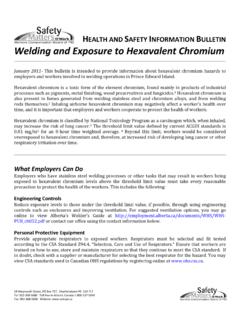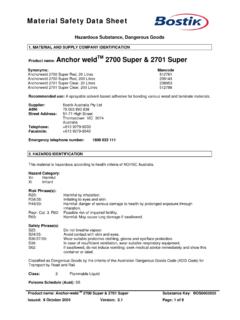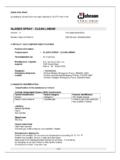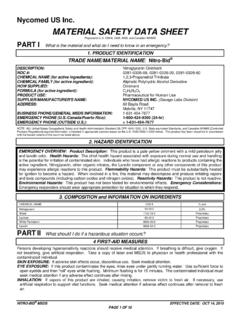Transcription of safety first your Putting Understanding paint …
1 PuttingyoursafetyfirstSurface coatings Organic solvents Lead-based paintRespirators and breathing apparatus Protecting your eyes Polyurethanes and lacquersSafety checklist - part one safety checklist - part twoUnderstandingpaint hazards andessential precautionsBetween three and four thousand estimated deathsare due to industrial cancers every year*Identify your toluene\xyleneWear correct protection for the glove up, mask upEnsure correct ventilation for your site and extractor fansRemember VOC/s are heavier than extract from ground levelBe site safe for yourself and other remember your work matesUse less toxic waterborne instead of solventborne, where possiblesee for more informationIn 1989 the International Agency for researchon cancer classified the occupation of painting as agroup 1 Carcinogen [causing cancer]GLOVE UP SOLVENTS CAUSE CANCER!(reprinted with permission from )*in New Zealand1 Surface coatingsWhat are paints made of?
2 The major constituents of most paints can begrouped into four general can enter the body through inhalation,absorption through the skin, or ingestion, with themost common route being inhalation. There is arisk of chemicals entering the body during mixing,application and clean up when using application presents the greatest hazardas the applicator is not just exposed to thehighly volatile portion of the paint (solvents)but also to the paint are the hazards?1. ResinsResins themselves are not classified as toxic,however, it is possible for some resins to beasthma causing agents and induceinflammation of the mucous membranes also react with the moist tissues of therespiratory system and eyes, causing irritation,or may be very irritating to the there are a lot of misconceptionsabout isocyanates, it is important tounderstand the major health issues and theseare addressed under Polyurethane paints andlacquers in this typical effects of overexposure toisocyanates includes chills, fever, flu likesymptoms and tightness of the , polyamines, polyamides have beenknown to cause dermatitis.
3 When skin contactdoes occur, wash thoroughly with lukewarmwater and PigmentsLead and Zinc/lead chromates: The toxic effectsof these are well documented. Lead poisoningsymptoms include general weakness, loss ofappetite, inability to sleep, irritability, painsin the muscles, joints and abdomen, mentalretardation, anaemia, sterility, central nervoussystem disorders and reproductive Lead-based paint in this brochure forfurther information. Zinc/lead chromates havebeen implicated in lung cancer of workershandling these in the finished paint are locked upby encapsulation in the resinous binder,however, sanding creates dusts in whichpigments are more SolventsSolvents cause headaches, drowsiness andunconsciousness, irritation to the skin, eyesand respiratory tract, and central nervoussystem depression with similar symptoms todrunkenness. People can become addicted tosome of these solvents and drinking alcoholduring the day may increase the toxic risksof these hands in solvents, such as turpentine,will de-fat the skin and can cause dermatitisand repeated exposure may result in solvents used in paints are highlyflammable so care needs to be taken thatthere are no sources of ignition available tothe solvent or to solvent/air drums contain residues of solvents thatcan be more dangerous than full drums, asthe danger of explosion is AdditivesAdditives may irritate the eyes, skin andrespiratory spray mist of paintsWhatever the brand or chemical nature of thepaint, the spray mist of that paint will contain:ResinsPigmentsSolventsAdditivesT he mist should not be inhaled, should not getonto skin and should not get into in the preparation forpaintingPaint stripper Extra care needs to be taken with materialscontaining methylene chloride.
4 This chemical is a suspected human carcinogenand can cause permanent damage to skinand eyes. Methylene chloride is highly toxic and cancause headaches, nausea, vomiting, numbness,tingling, light-headedness, worsen angina,loss of co-ordination, diarrhoea, abdominalpain, convulsions, unconsciousness, damageto lungs, liver function and pre-treatmentThese mixtures often contain phosphoric of this, the following hazards exist: Corrosive: will burn skin and eyes, permanentdamage may result. Reacts with metal to produce hydrogen gas,which is highly Wood dusts from cutting and sanding canproduce eye injury and asthma. Hardwood dusts are a suspected cause oflung cancer. Concrete/brick dusts from angle grinding cancause silicosis, lung cancer and eye injury. Abrasive blasting creates dense clouds ofdusts that contain the abrasive itself,pulverised surface paints and abradedsubstrate material. This can cause serious andirreversible lung damage.
5 If silica sand is used as a blasting medium,the resulting silica dust can cause silicosis ofthe lungs, which is characterised by chronicshortness of breath. Can lead to lung cancer. Lead-based paint dust can cause leadpoisoning, which can be fatal. Refer Lead-based paint in this brochure for fumes General welding fumes require similarrespiratory protection to those for exposure to excessively high noise levels overtime can result in permanent hearing loss. If noise from machinery makes it difficult foremployees working next to each other tospeak in a normal tone of voice, the workplacenoise level is probably too solventsMany are volatile. They give off a vapour and willevaporate quickly at room temperature. Not allgive out a strong word toxic is often used when referring to aharmful do you ensure that there will be no ill effectsfrom solvents used in your workplace? The firststep is for both employer and employees to knowabout and read the safety Data Sheet for eachproduct Data SheetsSafety Data Sheets (SDS) should be available atthe place of work for all to read.
6 These sheets detailthe hazards and set out the precautions for handlingthe chemical the SDS carefully. Look to see what the components of theproduct are. Check out the toxic properties. Follow the safety of solventsMany solvents evaporate and form vapour in theair when containers are left open. Their vapourscan be breathed in and lead to health problems. Store solvents in strong containers. Keep containers sealed or stoppered whennot being solvent vapours are highly flammable. Theywill readily create an atmosphere in which a firecan start. Work out evacuation routes. Keep evacuation routes free of any all solvents are of what you are dealing with is vitalto the proper methods of handling these and all times take special care to: Reduce the volume of flammable solventspresent as far as possible. Prevent spills and leaks. Exclude sources of ignition such as nakedlights, unsuitable electrical equipment, staticelectricity hazards, hot surfaces andmechanical friction.
7 Reduce the vapour concentration byventilation/extraction hazardsSolvents can enter the body by three routes. Inhaled into the lungs. Absorbed through the skin. a harmful vapour is the most solventsUnder the Health and safety in Employment Act 1992, if you are an employee, the Act givesyou responsibility for your own safety and health at work and employers to provide a safe andhealthy work signsThe toxic effects of solvents may be noticedimmediately, some time later or poisoningThe first effects are: A light-headed feeling. Slower reaction time. Poorer co-ordination, balance and power by Nausea and dizziness getting more and moresevere. Loss of to do Remove the person or people away fromexposure to the vapour. Check the first aid instructions on the labeland poisoningAfter years of repeated exposures, the typical latereffects are: Mood changes. Tiredness. Weakness. Persistent dermatitis. Effects on the liver and to doIf you believe you may be suffering from theseeffects, see your affect the skinSolvents dissolve the fat contained in human skinand remove the natural protection can cause skin rashes and repeated orprolonged exposure may result in chronic to do Use hand cleansers.
8 Do not wash your handsin a solvent. Have and use properly designed equipment. Wear protective gloves and clothing risk of injury or disease increases with howlong you are exposed to the solvent and how muchsolvent vapour is in the good rule of thumb is that the longer the exposure (years) and the higher the dose, the greater thehealth of harmful solvents Use personal protective equipment. Protect the skin and eyes. Prevent inhalation. Avoid working in a confined space. Store aidRefer to the SDS for appropriate exposure Remove contaminated clothing, usingappropriate gloves if available. Wash contaminated skin with lots of waterfrom a shower, hose or help a victim of over- exposure to solventvapours: Immediately remove the victim from theatmosphere in which the over-exposureoccurred. Keep the victim warm and unconscious, if breathing is distressed, or ifvictim is cyanosed (blue in colour): Ensure the airway is open press the headbackwards and lower jaw forwards so thatthe chin juts out.
9 Place the victim in the recovery position. Support breathing by mouth to mouthresuscitation. Use CPR if necessary. Seek medical attention If conscious, give plenty of water to drink. Donot cause vomiting. If unconscious do not give anything by false teeth, clean mouth of solvent,mucus and vomit. Follow instruction forunconscious victims given above. Refer to first aid instructions and the SDS forspecific information can be obtained fromAUST: POISONS INFORMATION CENTRE131 126 or call Resene 1800 738 : NATIONAL POISONS CENTRE0800 POISON (764 766) or call Resene0800 737 protectionIf solvent gets into the eye: Wash immediately with clean running water,lifting both lids repeatedly while doing so andkeeping the eye open. Continue to wash the eye without break forat least 15 minutes. If the irritation still persistsafter this, seek medical attention withoutdelay. If the affected person is wearing contactlenses, the eyes should be flushed constantlyuntil the person is able to remove thesecontact informationFor further information refer to Practical Guidelines for the Safe Use of Organic Solvents publishedby Occupational safety and Health Service, the gloves resistant to the chemicals beingused?
10 Gloves that swell and distort allowsolvents to penetrate to the the overalls impervious to the chemicalsbeing used? you need regular safety boots or antistaticboots? the process used require earthing straps? the work area well ventilated? are the extracted fumes going to? you have the correct type of respirator forthe job? (A dust mask will not protect againstsolvents). the respirator fit? (They are not effectiveunless a good face seal is being with beards, side burns, glasses ormissing dentures may need a different typeof respirator to ensure protection). you wearing your respirator if required?If not, why not? Is it uncomfortable? (Adifferent brand or style of respirator may bemore comfortable and therefore more readilyworn). the cartridges being replaced often enoughand is cartridge use being logged? you have air-fed respirators when workinginside tanks or in other areas where ventilationis poor? Those working inside tanks musthave a partner on the is the air supply coming from?
